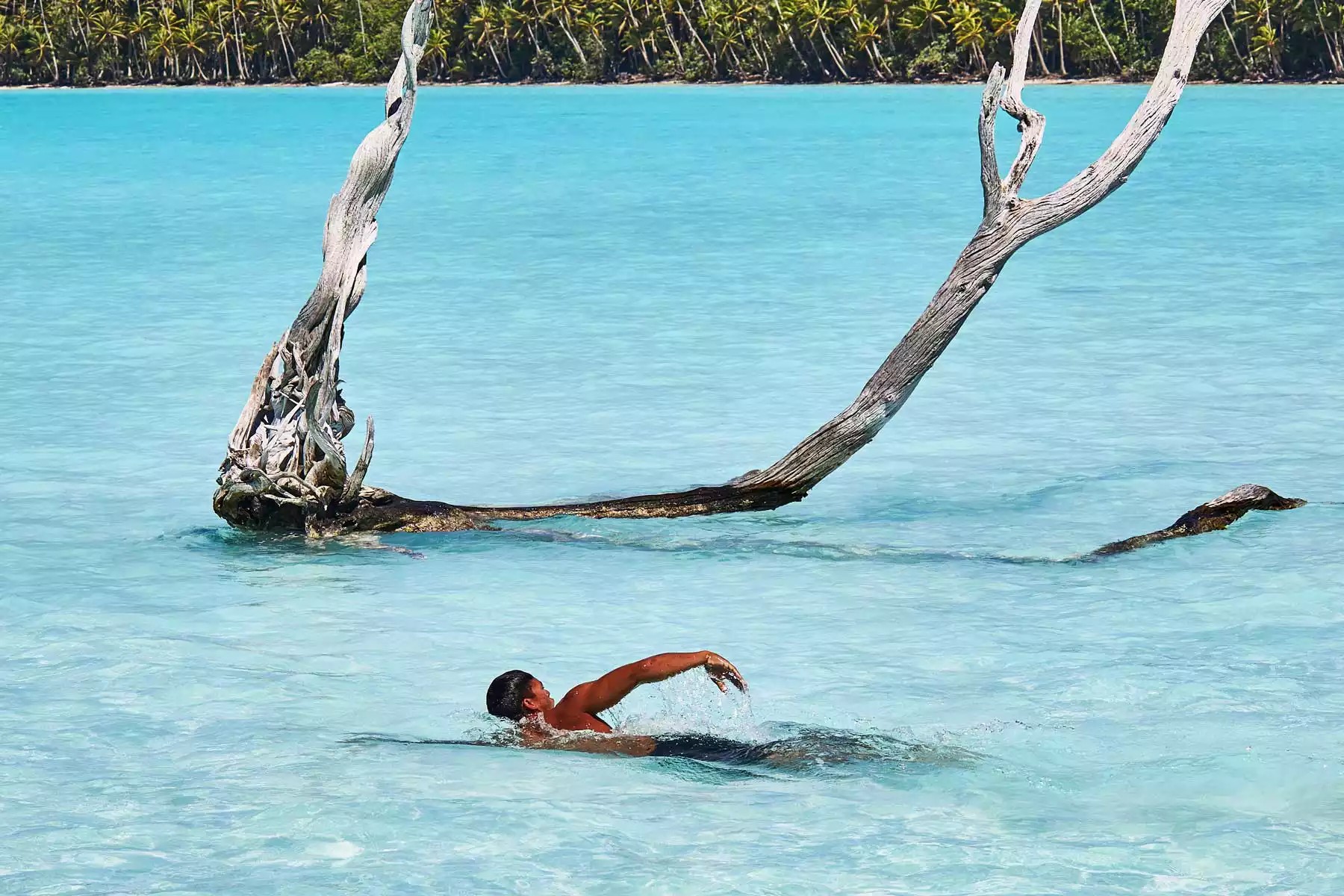Summary
Heritage of French Polynesia
In French Polynesia, a creative cohort of artists, chefs, farmers, and storytellers are reaffirming the islands’ heritage.
We were standing ankle-deep in a lagoon off the island of Raiatea when my guide, Tahiarii Yoram Pariente, spotted a pod of dolphins playing about 300 feet offshore.
“That’s mana,” he said.
The sky had spat rain for the 45 minutes since we’d arrived at Taputapuatea, a complex of seaside marae—massive, rectangular platforms hewn from stone a thousand years ago—and we had the place largely to ourselves. The whole time, Pariente, one of French Polynesia’s last traditional navigators, kept circling back to the concept of mana. He was mid-soliloquy when the frolicking dolphins appeared. He smiled in satisfaction, as if the creatures had confirmed the sacred power of this spot.
In ancient times, Taputapuatea, Pariente said, “was like the Jerusalem of Polynesia.” For centuries, chiefs, priests, shamans, and students gathered there for religious ceremonies, political negotiations, and master classes in navigation. Canoe after canoe had pulled into the shallows where we stood after journeying across the ocean—from Hawaii to the north, New Zealand to the south, Easter Island to the east—all returning, like so many sea turtles, to their ancestral home.
Cultural Revival and Mana
In the 1770s, warriors from Bora-Bora, 34 miles to the northwest, sacked Taputapuatea. The marae sat in disarray until the 1990s, when archaeologists began reassembling the stones. In 2017, Taputapuatea was declared a UNESCO World Heritage site, and restoration continues to this day. “You could look at all this and say, ‘It’s just stones, sand, and a good story,'” Pariente said. “But you have to admit that it’s a great story.”
As we skirted a low stone wall marking the edge of one reconstructed marae, Pariente invited me to imagine clusters of wise men, some sharing tales in the shade of fig trees, others making offerings. “There was no ceiling,” he said. “The sky is the ceiling.” Though Taputapuatea had lain ruined for so many years, Pariente believed the site had never lost its mana.
Chefs, artists, farmers, and storytellers are reinvigorating a culture once threatened. They’re wrestling with what it means to be Polynesian. And they’re reminding visitors that this is more than a one-dimensional postcard paradise dotted with overwater villas. It’s somebody’s home.
There was that word again: mana. Everywhere I went in French Polynesia, people kept mentioning mana. Watch for it, they said. Wait for it. But what was it?
“It’s difficult to explain,” they said.
A steadying essence.
A spiritual force.
A presence.
Exploring Tahiti and Its Culinary Delights
Today, the old ways are returning in new forms. Chefs, artists, farmers, and storytellers are reinvigorating a culture once threatened by dilution, even erasure. They’re wrestling with what it means to be Polynesian. And they’re reminding visitors that this is more than a one-dimensional postcard paradise dotted with overwater villas. It’s somebody’s home.
Until A.D. 300, no humans lived on these islands. Several millennia ago, seafarers are said to have set off from Taiwan (modern Polynesians share significant DNA with Taiwan’s Indigenous people). They slowly hopscotched across the ocean—to Fiji, then to Tonga, eventually settling in what’s now French Polynesia.
Though other parts of the country are better known—Tahiti, the largest island and the only one with an international airport, and Bora-Bora, which some locals call “the American island” because of its popularity with U.S. tourists—Raiatea has always been the archipelago’s cultural and religious heart. Raiatea was once called Havai’i—which, roughly translated, means “homeland” or “dwelling of the ancestors.”
Island Living: Moorea and Tetiaroa
From Raiatea, navigators took settlers north to Hawaii, southwest to New Zealand, and southeast to Easter Island, guided by the stars, sea creatures, and currents. “People fixate on the stars because they’re so visible, but there are many more layers of information,” Pariente said. “On a cloudy day, forget about the stars. You need the wind, the birds, the swells, and faith in your ancestors, who traced paths before you. It’s all part of the database.”
Today, the database is rarely passed down. Pariente wasn’t reared with it. Born to a Raiatean mother and a Tunisian Jewish father, he spent most of his childhood in France, studied in Australia, and only returned to French Polynesia in 2008, when he began learning from elders in the community, many of whom act as cultural custodians. He estimates that in all of French Polynesia, there are only five other people “with whom I’d go out on the ocean and trust my life,” he said. Potential apprentices quickly disappear when he gives them their first assignment: to sit in the same spot and watch the sky every night for one year. “Not looking, but watching—really watching. Then comes the exploring.”
A Polynesian Primer
The top islands to explore in French Polynesia include Tahiti, Raiatea, Tahaa, Moorea, and Tetiaroa, each with its unique offerings from luxurious resorts to vibrant local culture.




